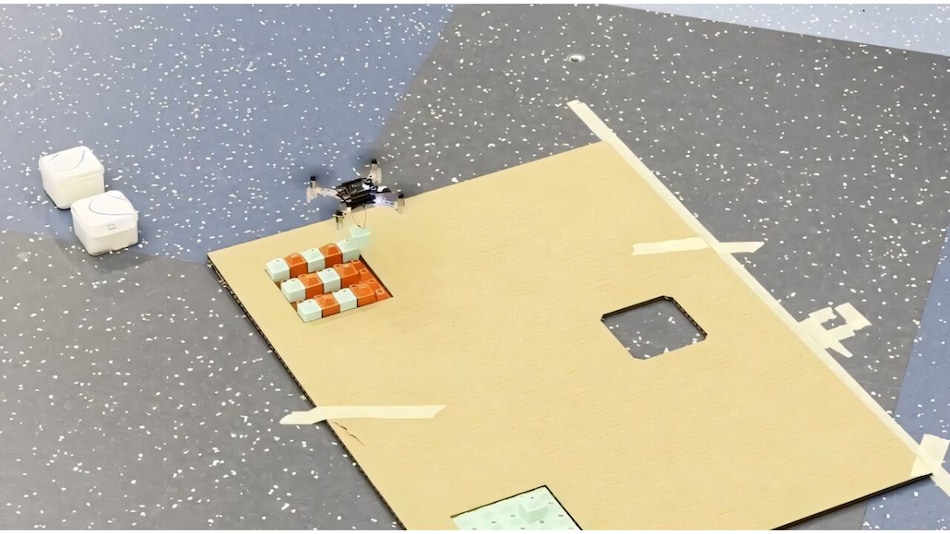- Home
- Science
- Science News
- Carnegie Mellon’s AI Drones Can Build Mid Air Structures With 90 Percent Success Rate
Carnegie Mellon’s AI Drones Can Build Mid-Air Structures With 90 Percent Success Rate
Carnegie Mellon engineers built AI-controlled drones that assemble magnetic blocks mid-air.

Photo Credit: Carnegie Mellon University Mechanical Engineering
Carnegie Mellon’s AI drones 3D print magnetic blocks mid-air for autonomous construction
Carnegie Mellon University engineers have integrated drones, 3D printing, and artificial intelligence to create flying robots, which can construct buildings in remote or dangerous locations. The drones that are controlled through AI are designed to use magnetized blocks rather than extruded plastic so that they can be assembled in a sturdy manner even during flight. A huge language model (LLM) interprets straightforward instructions into construction plans and corrects them in real time, and succeeds in constructing them 90 percent of the time.
Drone-Based 3D Printing System
According to the paper, in lab tests, small quadcopter drones carried and placed tiny magnetized blocks to form structures in mid-air. This “aerial additive manufacturing” sidesteps the stability problems of extrusion 3D printing. The blocks snap together like LEGO bricks, so the drone does not have to hold a steady position. An onboard AI (an LLM) acts like an architect, interpreting commands (for example, “build a bridge”) into step-by-step assembly instructions. A camera observes progress; if a block is misplaced, the AI recalculates a new plan on the fly rather than restarting. This closed-loop approach achieved 90% success in building test shapes.
Applications and Future Outlook
Researchers envision numerous applications other than lab tests. In one instance, Farimani proposes that someday the potholes will be filled with drones, spacecraft in orbit will be repaired, and that the pipes would be built in remote mountains where heavy machinery is unable to access. The team will take their system outside and test it against the real-life conditions and more intricate 3D designs and new materials. A combination of AI planning and aerial assembly would be able to put swarms of smart drones to work on infrastructure repairs and create emergency shelters in disaster areas.
Get your daily dose of tech news, reviews, and insights, in under 80 characters on Gadgets 360 Turbo. Connect with fellow tech lovers on our Forum. Follow us on X, Facebook, WhatsApp, Threads and Google News for instant updates. Catch all the action on our YouTube channel.
Related Stories
- Samsung Galaxy Unpacked 2025
- ChatGPT
- Redmi Note 14 Pro+
- iPhone 16
- Apple Vision Pro
- Oneplus 12
- OnePlus Nord CE 3 Lite 5G
- iPhone 13
- Xiaomi 14 Pro
- Oppo Find N3
- Tecno Spark Go (2023)
- Realme V30
- Best Phones Under 25000
- Samsung Galaxy S24 Series
- Cryptocurrency
- iQoo 12
- Samsung Galaxy S24 Ultra
- Giottus
- Samsung Galaxy Z Flip 5
- Apple 'Scary Fast'
- Housefull 5
- GoPro Hero 12 Black Review
- Invincible Season 2
- JioGlass
- HD Ready TV
- Laptop Under 50000
- Smartwatch Under 10000
- Latest Mobile Phones
- Compare Phones
- Lava Play Max
- Poco C85 5G
- Honor Magic 8 Lite
- Jolla Phone
- Realme P4x 5G
- OnePlus Ace 6T
- Nubia Flip 3
- Nubia Fold
- Asus ProArt P16
- MacBook Pro 14-inch (M5, 2025)
- OnePlus Pad Go 2
- Poco Pad M1
- Just Corseca Skywatch Pro
- Honor Watch X5
- Acerpure Nitro Z Series 100-inch QLED TV
- Samsung 43 Inch LED Ultra HD (4K) Smart TV (UA43UE81AFULXL)
- Asus ROG Ally
- Nintendo Switch Lite
- Haier 1.6 Ton 5 Star Inverter Split AC (HSU19G-MZAID5BN-INV)
- Haier 1.6 Ton 5 Star Inverter Split AC (HSU19G-MZAIM5BN-INV)

















